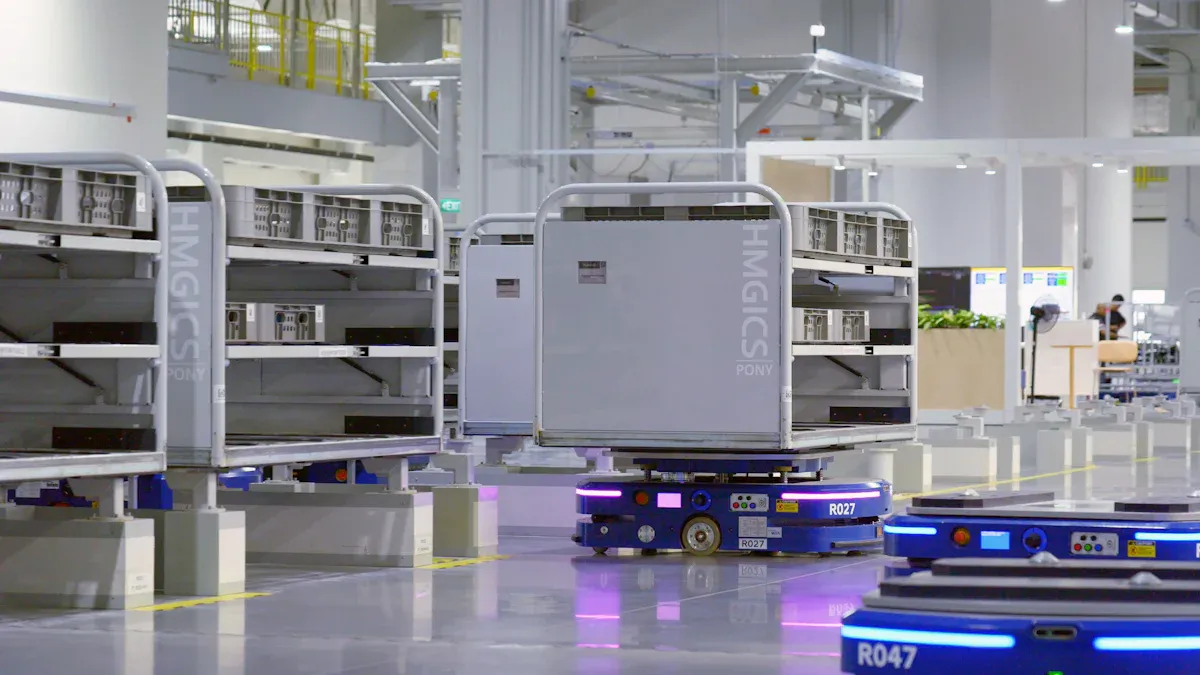Human-Robot Teams: How WMS Orchestrates Cobots in Modern Warehouses

Warehouses today are buzzing with activity, but it’s not just humans doing the heavy lifting. Human-robot teams are transforming how warehouses operate, and at the heart of this collaboration lies Warehouse Management Systems (WMS). These systems act as the brain, ensuring cobots and humans work together seamlessly.
Why does this matter? Consider this: nearly six injuries occur for every 100 full-time warehouse workers, with many requiring time off. Cobots reduce these risks by handling strenuous tasks. Plus, the average U.S. warehouse loses 6.9 weeks annually to unnecessary movement, costing $4.3 billion. WMS minimizes this waste by orchestrating cobots to streamline workflows and boost productivity.
By bridging the gap between human effort and robotic precision, WMS ensures warehouses run smarter, safer, and faster.
Key Takeaways
Cobots make warehouses safer by doing heavy and risky jobs. This helps lower workplace injuries a lot.
Warehouse Management Systems (WMS) improve work by using live data to assign tasks. This makes work faster and more efficient.
Human-robot teams can boost work output by up to 85%. Workers can focus on harder tasks while cobots do simple, repeated jobs.
Adding AI to WMS helps predict needs. It makes managing inventory better and adjusts to changes quickly.
Cobots are becoming more common and may make up 34% of the world’s robot market by 2025. They are changing how warehouses work.
Understanding Human-Robot Teams in Warehousing

Key Roles of Cobots in Warehouses
Assisting with Repetitive Tasks
Cobots excel at handling repetitive and time-consuming tasks. For example, they can optimize picking routes in real-time using AI and IoT sensors, reducing unnecessary walking. This not only saves time but also minimizes worker fatigue. Companies like Amazon have used cobots to cut order fulfillment times from one hour to just 15 minutes.
Enhancing Human Productivity
By taking over mundane tasks, cobots allow human workers to focus on more complex and value-added activities. Research shows that human-robot teams are 85% more productive than humans or robots working alone. This synergy boosts overall efficiency and helps warehouses meet growing demands, especially during peak seasons.
Improving Workplace Safety
Cobots play a crucial role in reducing workplace injuries. They handle heavy lifting and hazardous tasks, keeping workers out of harm’s way. With nearly six recordable injuries per 100 full-time warehouse workers, cobots are a game-changer for safety. For instance, Nike has tripled its e-commerce order capacity while improving workflow efficiency by integrating cobots into its operations.
How WMS Orchestrates Cobots
Task Allocation and Workflow Optimization
Assigning tasks based on real-time data
Warehouse Management Systems (WMS) excel at assigning tasks efficiently by leveraging real-time data. They analyze factors like order priorities, inventory levels, and cobot availability to ensure tasks are distributed effectively. For instance, if a cobot is closer to a specific picking zone, WMS assigns it the task, reducing unnecessary movement. This automation not only saves time but also minimizes errors.
Real-time data access allows quick decision-making.
Integration with other systems reduces manual work and improves accuracy.
By streamlining workflows, WMS ensures that both humans and cobots focus on what they do best, creating a harmonious and efficient operation.
Balancing workloads between humans and cobots
Balancing workloads is crucial for maintaining productivity in human-robot teams. WMS monitors the performance of both humans and cobots to distribute tasks evenly. For example, cobots can handle repetitive or physically demanding jobs, while humans focus on tasks requiring problem-solving or creativity. This balance prevents burnout and ensures consistent output.
Real-Time Monitoring and Coordination
Tracking cobot performance and location
WMS provides real-time tracking of cobots, ensuring they operate at peak efficiency. Managers can monitor cobot performance, identify bottlenecks, and make adjustments as needed. For example, if a cobot slows down due to a technical issue, WMS can reroute tasks to another cobot or human worker. This level of oversight keeps operations running smoothly.
Ensuring seamless collaboration
Seamless collaboration between humans and cobots is essential for success. WMS acts as a mediator, ensuring tasks are handed off smoothly between team members. For instance, when a cobot completes a picking task, WMS notifies the human worker responsible for packing. This coordination eliminates delays and enhances overall efficiency.
Data-Driven Decision-Making
Leveraging analytics to improve efficiency
WMS uses advanced analytics to optimize warehouse operations. Predictive inventory management, for example, analyzes historical sales data to forecast demand accurately. Route optimization reduces travel time by prioritizing orders and analyzing traffic conditions. These insights help warehouses operate more efficiently and meet customer expectations.
Adapting to changing warehouse demands
Warehouses face constant changes in demand, especially during peak seasons. WMS adapts by using demand sensing to adjust inventory and production strategies in real time. It also monitors labor productivity to optimize workforce allocation. This adaptability ensures warehouses remain flexible and scalable, even under pressure.
Human-robot teams thrive when WMS orchestrates their efforts. By combining real-time data, monitoring, and analytics, WMS creates a dynamic environment where humans and cobots work together seamlessly.
Benefits of WMS-Coordinated Human-Robot Teams
Enhanced Efficiency and Productivity
Faster order fulfillment
WMS-coordinated human-robot teams significantly speed up order fulfillment. Cobots optimize picking routes and reduce unnecessary walking, saving valuable time. For instance, the average U.S. warehouse loses 6.9 weeks annually to inefficient movement, costing $4.3 billion. Cobots eliminate this waste by streamlining processes and minimizing human error. This results in faster order processing and improved customer satisfaction.
Cobots enhance productivity by reducing manual intervention.
They optimize workflows, ensuring tasks are completed quickly and accurately.
Reduced downtime
Downtime can cripple warehouse operations, but WMS minimizes it by automating repetitive tasks and monitoring cobot performance. If a cobot encounters an issue, WMS quickly reroutes tasks to another team member, ensuring operations continue without interruption. This proactive approach keeps warehouses running smoothly and reduces costly delays.
Improved Safety and Ergonomics
Minimizing human exposure to hazardous tasks
Cobots handle strenuous and dangerous tasks, keeping workers safe. They lift heavy loads, work in high-risk areas, and perform repetitive motions that could otherwise lead to injuries. This reduces human exposure to workplace hazards and creates a safer environment for everyone.
Reducing workplace injuries
Warehouse injuries are common, with nearly six recordable incidents per 100 full-time workers. Cobots help lower this number by taking on physically demanding jobs. In fact, the accident rate involving cobots is just one per 1.6 million hours of use. This makes them a reliable solution for improving workplace safety while boosting efficiency.
Flexibility and Scalability
Adapting to seasonal demand fluctuations
WMS-coordinated strategies allow warehouses to adapt quickly to seasonal changes. Predictive analytics forecast demand, while dynamic task interleaving ensures seamless task switching. Automation focuses on fast-moving goods, improving accuracy during peak seasons.
Strategy | Description |
|---|---|
Predictive Analytics | Forecasts demand to optimize labor and inventory management. |
Dynamic Task Interleaving | Enables workers to switch tasks efficiently, enhancing workflow flexibility. |
Automation and Robotics | Manages high-density SKUs for better accuracy and speed. |
Inventory Optimization | Adjusts stock levels based on demand signals to prepare for peak periods. |
Scaling operations with ease
As businesses grow, WMS ensures scalability by integrating advanced technologies. SaaS-based WMS solutions, for example, allow rapid deployment and operational agility. This makes it easier for warehouses to expand without compromising efficiency or reliability.
Human-robot teams thrive in environments where WMS provides flexibility and scalability. These systems empower warehouses to meet fluctuating demands and grow seamlessly.
Challenges and Solutions in Integrating Cobots with WMS
Integration Challenges
Compatibility with existing systems
Integrating cobots with existing warehouse systems can feel like trying to fit a square peg into a round hole. Many warehouses rely on legacy systems that weren’t designed to communicate with modern technologies like cobots. This lack of compatibility can lead to inefficiencies and delays. For example, older systems may struggle to process real-time data from cobots, creating bottlenecks in operations.
To address this, businesses often need to upgrade their Warehouse Management Systems (WMS) or invest in middleware solutions. These upgrades ensure seamless communication between cobots and other systems, paving the way for smoother operations.
High initial investment costs
Cobots and WMS upgrades don’t come cheap. The upfront costs of purchasing cobots, installing new systems, and training employees can be daunting for many businesses. However, these investments often pay off in the long run through increased efficiency and reduced labor costs. Companies must weigh the initial expense against the long-term benefits to make informed decisions.
Workforce Training and Adaptation
Educating employees on cobot collaboration
Introducing cobots into a warehouse isn’t just about technology—it’s also about people. Employees need proper training to work effectively alongside cobots. A study by Deloitte and The Manufacturing Institute highlights the urgency of this issue. It predicts a shortage of 2.1 million skilled workers in the U.S. manufacturing sector by 2028, emphasizing the importance of comprehensive training programs.
Evidence | Description |
|---|---|
Study by Deloitte and The Manufacturing Institute | Indicates a potential shortage of 2.1 million skilled workers in the US manufacturing sector by 2028, emphasizing the need for comprehensive training programs to equip employees with skills for operating and maintaining cobots. |
Addressing resistance to change
Change can be intimidating, especially when it involves working with robots. Some employees may worry about job security or feel overwhelmed by new technology. Open communication and hands-on training can help ease these concerns. When employees understand how cobots enhance their roles rather than replace them, they’re more likely to embrace the change.
WMS Solutions to Overcome Challenges
Providing user-friendly interfaces
Modern WMS platforms prioritize user-friendly designs, making it easier for employees to adapt. Intuitive dashboards and simple controls reduce the learning curve, allowing workers to focus on their tasks rather than struggling with the system.
Offering scalable and customizable solutions
Scalable WMS solutions grow alongside businesses, adapting to changing workflows and demands. Customization options let warehouses tailor the system to their specific needs, ensuring seamless integration. These systems also connect with other business tools like ERP and CRM platforms, streamlining operations across the board.
Scalability ensures the system evolves with the business.
Customization allows workflows to match unique warehouse operations.
Compatibility with existing technology improves overall efficiency.
By investing in these solutions, warehouses can overcome integration challenges and unlock the full potential of human-robot collaboration.
The Future of Human-Robot Teams in Warehousing

Emerging Trends in WMS and Robotics
AI-driven WMS for predictive analytics
Artificial intelligence is revolutionizing warehouse management systems (WMS). AI-driven WMS uses predictive analytics to anticipate demand, optimize inventory, and streamline operations. For example, warehouses can achieve up to 99% inventory accuracy, a 76% improvement compared to traditional methods. These systems also reduce labor costs by 3% annually and ensure consistent one-day shipping, improving efficiency by 40%.
The market for AI-driven WMS is growing rapidly, with a compound annual growth rate (CAGR) of 15.3% projected from 2021 to 2028. This growth reflects the increasing reliance on automation and robotics to meet rising consumer expectations.
Advanced cobots with enhanced capabilities
Collaborative robots, or cobots, are evolving quickly. Newer models feature advanced sensors, AI integration, and machine learning capabilities. These upgrades allow cobots to perform more complex tasks, such as real-time route optimization and dynamic task switching.
The global robotics market is expected to reach $13 billion by 2025, with cobots accounting for 34% of sales, up from just 3% today. This surge highlights their growing importance in modern warehouses. Businesses are adopting cobots to reduce errors, improve safety, and boost productivity.
Long-Term Potential of Human-Robot Collaboration
Fully automated warehouses
The future of warehousing may include fully automated facilities. These warehouses will rely on human-robot teams to handle everything from inventory management to order fulfillment. Automation reduces human error, speeds up processes, and lowers operational costs.
Redefining workforce roles in logistics
As robots take over repetitive tasks, human workers will shift to roles requiring creativity and problem-solving. This transition will redefine logistics jobs, focusing on strategic planning and system management. Human-robot teams will continue to drive innovation and efficiency in the industry.
Warehouse Management Systems (WMS) have revolutionized how humans and cobots collaborate, creating smarter and safer operations. By orchestrating tasks, WMS ensures cobots handle repetitive and strenuous jobs, allowing workers to focus on more complex responsibilities. This synergy boosts productivity by up to 85%, reduces unnecessary movement, and minimizes workplace injuries.
Cobots now account for just 3% of robotics sales in warehousing but are projected to grow to 34% by 2025.
They optimize picking routes in real-time, saving time and cutting costs.
Their flexibility allows quick deployment without major infrastructure changes.
The future of warehousing lies in this collaboration. As cobots evolve and WMS integrates AI-driven analytics, warehouses will become more efficient, adaptable, and scalable. Together, they’re redefining logistics and paving the way for fully automated operations.
FAQ
What makes cobots different from traditional robots?
Cobots are designed to work alongside humans, not replace them. They’re smaller, safer, and more adaptable than traditional robots. Unlike industrial robots that operate in isolated zones, cobots share workspaces with humans, making them ideal for dynamic environments like warehouses. 🤖✨
How does WMS improve human-robot collaboration?
WMS acts as the brain of warehouse operations. It assigns tasks, monitors performance, and ensures smooth coordination between humans and cobots. By leveraging real-time data, WMS optimizes workflows, reduces errors, and boosts productivity. Think of it as the ultimate team coach! 🏆
Are cobots safe to use in warehouses?
Absolutely! Cobots come equipped with advanced sensors and safety features. They can detect obstacles, avoid collisions, and stop immediately if needed. This makes them safe for humans to work alongside, reducing workplace injuries and creating a safer environment overall. 🚧✅
See Also
Maximizing Efficiency Through Robotics In Warehouse Operations
Harnessing Robotics Technology To Improve Warehouse Efficiency
Embracing Automation: Advantages Of High-Tech Warehousing Solutions
The Importance Of Warehouse Automation For Business Success
Unveiling Robotics Innovations: Transforming The Supply Chain
